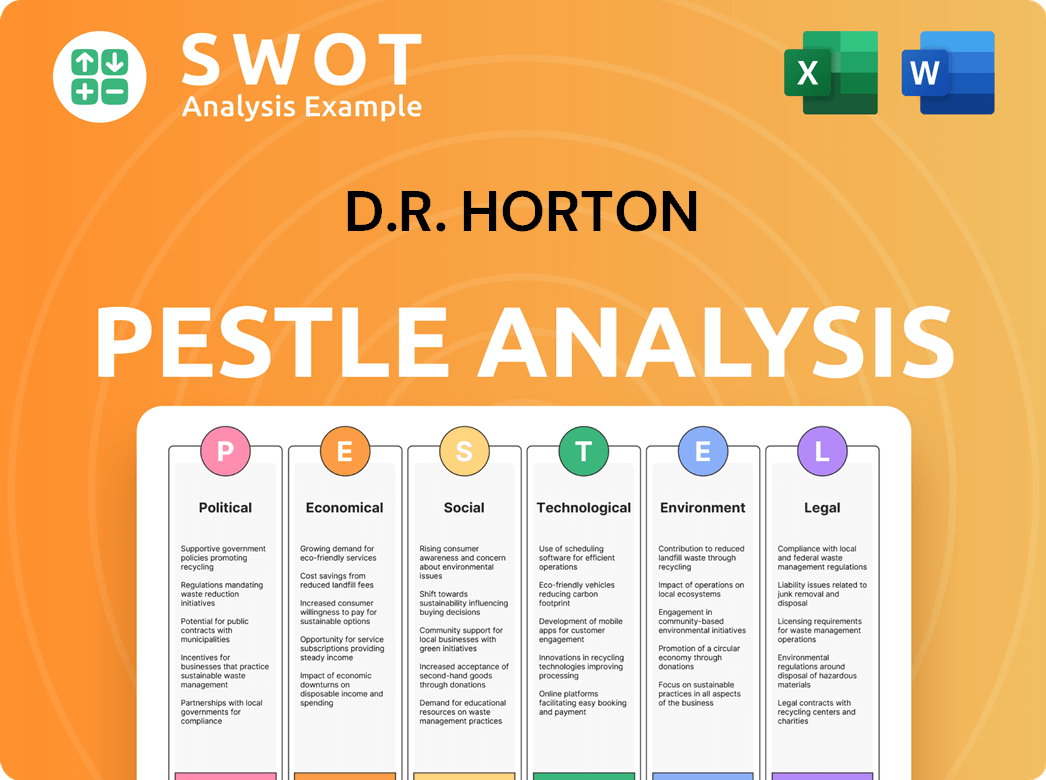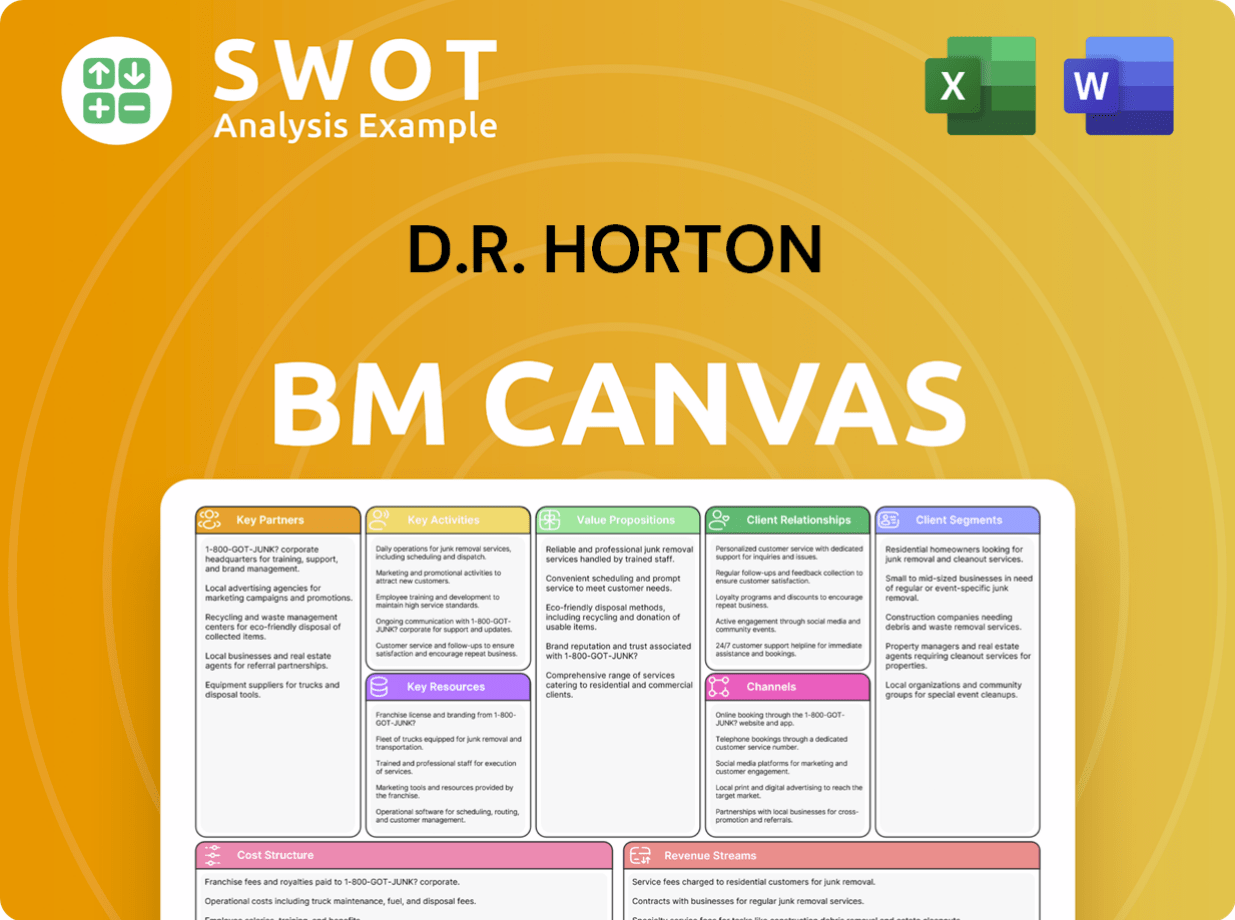D.R. Horton Bundle
Who Buys D.R. Horton Homes?
The housing market's pulse is dictated by the people who buy homes, and for D.R. Horton, understanding its D.R. Horton SWOT Analysis is key. As the largest homebuilder in the U.S., D.R. Horton's success hinges on a deep understanding of its customer demographics and target market. This exploration dives into the core of D.R. Horton's strategy: identifying and serving its ideal customer profile.

This deep dive into D.R. Horton's customer base reveals the homebuyer characteristics that drive its business. We'll analyze the company's market segmentation strategy, examining factors like customer income levels, homebuyer ethnicity, and family size. Understanding D.R. Horton's target market by location and its focus on first-time homebuyers, along with customer buying motivations, provides a complete picture of the company's approach to the dynamic real estate demographics.
Who Are D.R. Horton’s Main Customers?
The primary customer segments for D.R. Horton are primarily consumers (B2C) within the homebuilding sector. They focus on a broad spectrum of homebuyers, but with a strong emphasis on first-time and move-up buyers. This approach allows them to address a wider market, ensuring consistent demand across various economic conditions.
D.R. Horton’s diverse product portfolio caters to varying income levels and life stages. Their offerings suggest a target demographic that includes young professionals and families seeking their first home, as well as established families looking for larger or more amenity-rich properties. The company strategically segments its market to meet different needs.
Over time, D.R. Horton has adapted its target segments, particularly in response to interest rate fluctuations and housing affordability challenges. They emphasize more affordable entry-level homes to maintain sales volume. This shift is evident in their reported sales mix, with a continued focus on addressing the needs of first-time homebuyers, a segment that often represents a significant portion of the housing market. To understand more about their business model, you can read about the Revenue Streams & Business Model of D.R. Horton.
D.R. Horton targets a broad customer base within the homebuilding industry. Their focus includes first-time buyers, move-up buyers, and active adults. The company segments its market through different brands and home offerings to meet varied needs.
Express Homes caters to first-time homebuyers with affordable price points. The traditional D.R. Horton brand serves a wider range of buyers. Freedom Homes is designed for active adults, showcasing their segmentation strategy.
D.R. Horton adjusts its target segments based on economic factors like interest rates and affordability. They emphasize affordable entry-level homes to maintain sales volume. This strategy reflects their responsiveness to market changes.
The company focuses on first-time homebuyers, a significant segment of the housing market. Move-up buyers and active adults also form part of their target demographic. This diverse approach helps maintain demand.
D.R. Horton's customer base includes a mix of ages, income levels, and family sizes. They cater to a variety of lifestyles, from young professionals to established families. Their offerings are designed to meet diverse needs.
- First-time homebuyers are a significant segment.
- Move-up buyers seek larger or more amenity-rich homes.
- Active adults look for homes suited to their lifestyle.
- The company adapts to interest rate fluctuations.
D.R. Horton SWOT Analysis
- Complete SWOT Breakdown
- Fully Customizable
- Editable in Excel & Word
- Professional Formatting
- Investor-Ready Format

What Do D.R. Horton’s Customers Want?
Understanding the needs and preferences of its customers is crucial for the success of D.R. Horton. The company's approach to building homes is deeply influenced by the diverse motivations and requirements of its target market. This includes a focus on affordability, location, community, and design, catering to a wide range of homebuyers.
The Brief History of D.R. Horton reveals a consistent strategy of adapting to market trends and customer feedback. This adaptation is seen in the inclusion of features like open-concept living areas and smart home technology, reflecting current preferences. By understanding these factors, D.R. Horton can better serve its customer base.
The company's customer base is diverse, encompassing various demographics and preferences. This includes first-time homebuyers, move-up buyers, and those seeking specific lifestyle features. The company's ability to adapt to these varied demands is a key component of its market strategy.
For many customers, affordability is the primary driver. This includes manageable mortgage payments and overall home price. D.R. Horton addresses this by offering homes at various price points.
Location is a critical factor, with proximity to work, family, and desirable amenities. D.R. Horton strategically builds in locations that meet these needs. The company considers factors such as school districts and access to services.
Many buyers seek homes in communities with amenities like parks, pools, and recreational facilities. D.R. Horton often incorporates these features to enhance the appeal of its developments. These amenities contribute to the overall lifestyle and value of the homes.
Home design preferences vary, with some buyers preferring specific architectural styles and layouts. D.R. Horton offers a range of designs to cater to different tastes. This includes both traditional and modern styles.
First-time homebuyers often prioritize value and manageable mortgage payments. They typically seek functional layouts and low-maintenance properties. D.R. Horton offers homes that meet these needs.
Move-up buyers may prioritize more square footage, higher-end finishes, and specific architectural styles. They often seek homes in desirable school districts. D.R. Horton caters to these needs with larger homes and premium features.
D.R. Horton's customer base is influenced by a variety of factors, including economic conditions and lifestyle preferences. Understanding these factors is crucial for the company's success. The company's strategy focuses on meeting these diverse needs.
- Affordability: The company offers homes at various price points to cater to different budgets.
- Location: Strategic placement in desirable areas, considering proximity to work, schools, and amenities.
- Community: Inclusion of amenities like parks and pools to enhance lifestyle.
- Design: Offering a range of home designs to suit diverse preferences.
- Modern Features: Incorporating smart home technology and energy-efficient designs.
- Financial Services: Providing integrated financial services to streamline the homebuying process.
D.R. Horton PESTLE Analysis
- Covers All 6 PESTLE Categories
- No Research Needed – Save Hours of Work
- Built by Experts, Trusted by Consultants
- Instant Download, Ready to Use
- 100% Editable, Fully Customizable

Where does D.R. Horton operate?
D.R. Horton's geographical market presence is extensive across the United States. As of late 2023, the company operated in 110 markets spread across 33 states, showcasing a broad reach within the U.S. housing market. This wide distribution allows the company to capitalize on diverse regional economic conditions and homebuyer preferences, contributing to its overall resilience.
The company strategically focuses on major metropolitan areas and fast-growing suburban communities. These locations are chosen for their strong population growth and job market expansion, which are key drivers of housing demand. This targeted approach helps D.R. Horton to optimize its sales and operational strategies, ensuring alignment with market trends and customer needs.
Key markets for D.R. Horton include the Sun Belt regions like Texas, Florida, Arizona, and the Carolinas. These areas consistently show robust housing demand due to favorable demographics and economic migration patterns. For instance, Texas remains a strong market, with significant sales volume across its major cities. The company's ability to adapt to regional differences in customer preferences and buying power is crucial.
D.R. Horton strategically targets areas with high population and job growth, focusing on major metropolitan and suburban areas. This approach allows the company to capitalize on strong demand. The company's focus on these areas helps optimize sales and operational strategies.
The company adapts its product offerings to suit regional preferences, such as home styles and sizes. This customization helps meet diverse customer needs and preferences across different markets. For example, designs in suburban Dallas differ from those in coastal Florida.
D.R. Horton maintains a strong market share in many regions, leveraging its scale and operational efficiency. This strong market position is a result of their efficient operational model. By doing so, the company can better meet the needs of its target market.
The broad geographic distribution of sales contributes to D.R. Horton's resilience against localized economic downturns. Strength in one region can offset weaknesses in another, providing a more stable financial performance. This diversification is a key part of their strategy.
The company's strategy includes continuous evaluation of market conditions. This leads to strategic expansions into new high-growth areas and adjustments to inventory levels based on local demand. This proactive approach allows D.R. Horton to stay competitive. Understanding the Competitors Landscape of D.R. Horton is also important for strategic positioning.
D.R. Horton Business Model Canvas
- Complete 9-Block Business Model Canvas
- Effortlessly Communicate Your Business Strategy
- Investor-Ready BMC Format
- 100% Editable and Customizable
- Clear and Structured Layout

How Does D.R. Horton Win & Keep Customers?
The company employs a multi-faceted approach to acquire and retain customers, blending traditional and digital marketing strategies. Their customer acquisition strategy focuses on a strong online presence, utilizing both corporate and community-specific websites to showcase available homes, virtual tours, and community amenities. Digital marketing efforts, including search engine optimization (SEO) and pay-per-click (PPC) advertising, are central to reaching potential homebuyers.
Traditional marketing methods are still relevant, with signage at community entrances, model homes, and local advertising playing a role. Sales tactics rely heavily on on-site sales professionals who guide prospective buyers through the home selection and purchase process. The company's integrated financial services segment plays a significant role in both attracting and retaining customers by streamlining the buying experience and offering competitive rates.
Customer retention is addressed through after-sales service and warranty programs, aiming to ensure customer satisfaction and generate positive word-of-mouth referrals. The company's success is evident in its consistent ranking as the largest homebuilder in the U.S., reflecting the effectiveness of its acquisition and retention strategies. These strategies are built on scale, efficiency, and a deep understanding of the homebuyer journey. For more insights into the company's strategic direction, consider reading about the Growth Strategy of D.R. Horton.
The company utilizes digital marketing extensively, including SEO, PPC advertising, and social media engagement. These efforts are designed to reach a broad audience and drive traffic to their websites. These strategies help in showcasing properties and community features to potential customers.
On-site sales professionals are crucial in guiding prospective buyers through the home selection and purchase process. They highlight the benefits of new construction, financing options, and community features. Their role is to convert interest into sales.
The integrated financial services segment provides mortgage financing and title services, which simplifies the buying process. Offering competitive rates increases the likelihood of closing sales and fosters customer loyalty. This approach enhances customer retention.
Focus on after-sales service and warranty programs ensures customer satisfaction and generates positive word-of-mouth referrals. This is a key strategy for customer retention in the housing market. These programs are vital for long-term customer relationships.
The company adjusts its strategies based on market conditions. During periods of high demand, the focus shifts to efficient sales processes. In slower markets, more aggressive incentives or personalized outreach may be employed. This adaptability ensures continued success.
- During periods of high demand, the focus might shift to efficient sales processes.
- In slower markets, more aggressive incentives or personalized outreach may be employed.
- The company's strategy reflects a deep understanding of the homebuyer journey.
- The company's consistent ranking as the largest homebuilder in the U.S. for many years underscores the effectiveness of its acquisition and retention strategies.
D.R. Horton Porter's Five Forces Analysis
- Covers All 5 Competitive Forces in Detail
- Structured for Consultants, Students, and Founders
- 100% Editable in Microsoft Word & Excel
- Instant Digital Download – Use Immediately
- Compatible with Mac & PC – Fully Unlocked

Related Blogs
- What are Mission Vision & Core Values of D.R. Horton Company?
- What is Competitive Landscape of D.R. Horton Company?
- What is Growth Strategy and Future Prospects of D.R. Horton Company?
- How Does D.R. Horton Company Work?
- What is Sales and Marketing Strategy of D.R. Horton Company?
- What is Brief History of D.R. Horton Company?
- Who Owns D.R. Horton Company?
Disclaimer
All information, articles, and product details provided on this website are for general informational and educational purposes only. We do not claim any ownership over, nor do we intend to infringe upon, any trademarks, copyrights, logos, brand names, or other intellectual property mentioned or depicted on this site. Such intellectual property remains the property of its respective owners, and any references here are made solely for identification or informational purposes, without implying any affiliation, endorsement, or partnership.
We make no representations or warranties, express or implied, regarding the accuracy, completeness, or suitability of any content or products presented. Nothing on this website should be construed as legal, tax, investment, financial, medical, or other professional advice. In addition, no part of this site—including articles or product references—constitutes a solicitation, recommendation, endorsement, advertisement, or offer to buy or sell any securities, franchises, or other financial instruments, particularly in jurisdictions where such activity would be unlawful.
All content is of a general nature and may not address the specific circumstances of any individual or entity. It is not a substitute for professional advice or services. Any actions you take based on the information provided here are strictly at your own risk. You accept full responsibility for any decisions or outcomes arising from your use of this website and agree to release us from any liability in connection with your use of, or reliance upon, the content or products found herein.